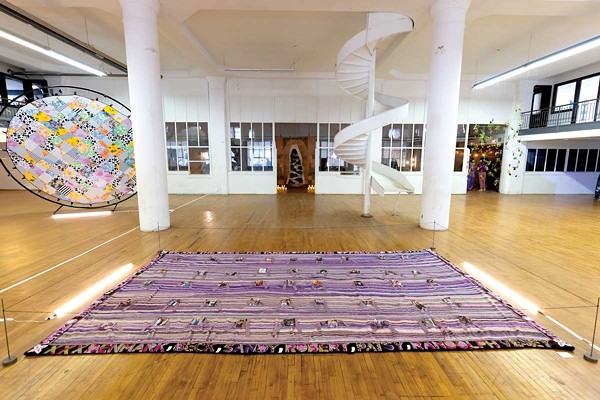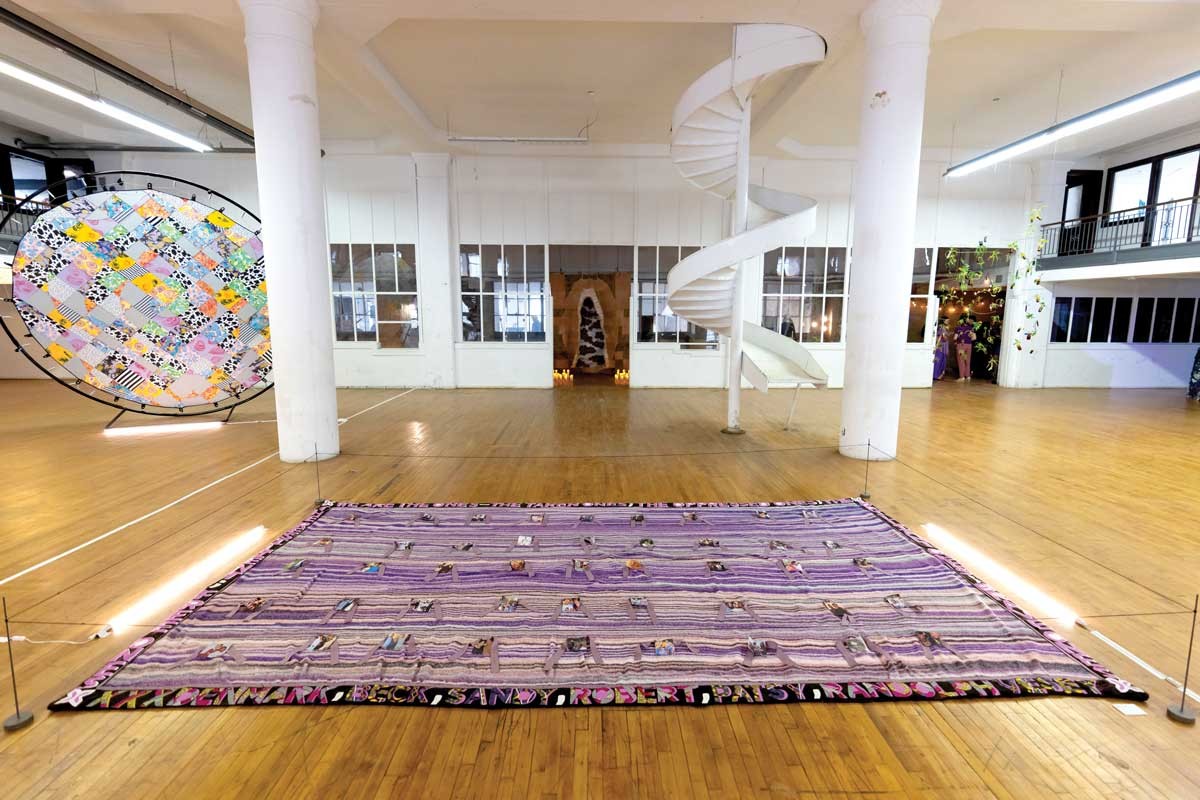Over 15 rooms inside the 16,000-square-foot Boyer Campbell Building in Detroit’s Milwaukee Junction neighborhood are filled with fiber art this month for an exhibit titled Environment + Microclimates.
The exhibit, which is part of Detroit Month of Design, features works by over 60 Detroit-area artists.
Larger-than-life quilts with political undertones, a hunting blind that examines gender, and a sustainable fashion display are just some of the pieces in the space — all made with fibers such as yarn, cotton, felt, and even wood.
The Environment + Microclimates exhibit is a collaboration between botanical artist Lisa Waud, arts writer and artist Sarah Rose Sharp, and Fiber Club*, a collective of Detroit-area fiber artists founded by Katie Shulman in 2022.
When Waud asked Sharp if she wanted to work together on a community installation, she said “yes” and suggested it involve Fiber Club*. Now, Shulman and over 60 other artists in the group are displaying work in the current show.
The theme, Environment + Microclimates, showcases how artists, though often small parts of larger communities, can still have a mighty impact.
Sharp defines a “microclimate” as a term in environmental science, emphasizing how small actions — like planting trees — can make a significant difference, much like the impact of fiber artists in this exhibit.
The exhibit demonstrates the wide variety of microclimates, as well as the uniqueness of fiber art and Detroit-area artists.
“I think my idea with Environment + Microclimates is to acknowledge artists as being part of a community, part of a landscape, and this broad environment of fiber art in Detroit, in metro Detroit, in Michigan, but also to understand that artists are creating a little world for themselves and for their viewers,” Sharp says. “My hope is that there’s a feeling as you move through the show that from place to place, the energy can be completely different, the temperature, the stimulus, what you’re seeing, how you’re feeling.”
Unique to many group exhibitions, the different subspaces in the Boyer Campbell Building have allowed artists to create mini solo shows branching off from the main exhibition room. Each space reflects the artists’ individual ideas and practices, demonstrating the diversity of the fiber medium and the vastness of microclimates.
To guide visitors through the expansive exhibition, Sharp created a “Field Guide” that includes critical views of each artist’s work, explaining their creative values and ideas. The guide also features a centerfold trail map to allow visitors to easily explore the space through different themes.
“It’s this huge survey of fiber art, but it is not pushing a single narrative about fiber art,” Sharp says. “My imperative is not to dictate what artists should be doing, but to really open opportunities and trust that artists are the best problem solvers and will figure out what to do to make a great show, and they really have.”
In Environment + Microclimates, fiber art takes on various forms, from direct interpretations to abstract installations. Some pieces incorporate ambient sound, while others invite interaction. The range of works spans political, spiritual, and sustainable themes, with most artists contributing multiple pieces.
One such artist is Irene Perez, whose work explores her Mexican heritage through a project titled Lupe, which has two iterations. The first, she says, recently helped her get into the Cranbrook Academy of Arts Master of Fine Arts program.
“It’s my take on Mexican identity through a piñata and a quilt,” Perez says. “The second iteration is a little bit more political in the sense that I am talking more about the family separation act that was implemented for a couple months, but it was a lot longer during Trump’s administration. I’m shining light on that little piece of history that we lived through.”
As a fiber artist, Perez says it’s encouraging to see such a large show of fiber art, recognizing how many dedicated artists of the medium are in Detroit.
“It’s just been an amazing opportunity to see how we all are able to come together, collaborate, and put together projects,” she says. “I feel really blessed to be a part of it.”
Environment + Microclimates is taking place at the epicenter of the Detroit Design District, a development in Milwaukee Junction that encourages artists to bring their businesses and projects to the stretch on E. Grand Blvd. Founded by Amelia Patt-Zamir in 2023, the district is funded by Method Development, a company that reactivates old buildings.
At the exhibit’s opening on Sept. 6, the whole neighborhood was involved. The event featured food from local restaurants Oak and Reel, drinks from local bar Kiesling, bites and sounds from gallery and bakehouse Someday, and interactive activities from local group Bulk Space.
Patt-Zamir says that collaboration and community within the local arts scene are at the heart of the Detroit Design District’s mission, and the month-long programming around the show will continue to reflect those values.


